The Market Square or, in German, the Main Market (Hauptmarkt) is the central square of Nuremberg, which is the heart of the city and is included in the tourist routes around the city.
Hauptmarkt Square is located in the center of the historic old town of Nuremberg, on the right (north) side of the Pegnitz River, next to the Church of St. Sebald (Sebalduskirche), which with its rear facade and high towers also forms the image of the Market Square.
The place where the Market Square is now located was originally (12th century) a swamp on the river bank. Locals preferred to settle higher - in more convenient places. At that time, Jews came to the city, and the swampy lowland was left to them as a place for settlement.
The Jews built their houses and a synagogue here, which was located on the site where the Frauenkirche is now located.
After the city fortifications of Nuremberg were completed (around 1320), the Jewish quarter ended up in the center of the city. In 1349, with the consent of Emperor Charles IV, a pogrom occurred, during which almost 600 Jews were killed and their ghetto was destroyed.
Two markets were built on the site of the Jewish ghetto: a Fruit Market (Obstmarkt/ Obstmarkt) and a Green Market (Grüner Markt /Gruner Markt) or a Flea Market (Großer Markt/Grosser Markt).
The market square was named "Hauptmarkt" in 1809 to highlight its status compared to other markets in the city.
At the beginning of the period of National Socialism, the square became the central place of party rallies and parades. On March 25, 1933, the name of the square was changed to "Adolf-Hitler-Platz" (Adolf-Hitler-Platz).
During the bombing of Nuremberg in January 1945, the buildings located on the square were almost completely destroyed.
When the US Army took Nuremberg on April 20, 1945, it renamed the square "Iron Mike Place" (Iron Mike Place). Iron Mike was the pseudonym of the commander of the general of the 3rd Infantry Division, John Wilson O'Daniel. John ordered the square to be renamed "Roosevelt Square" in honor of the president who had died eight days earlier. A few days later, the square was renamed Hauptmarkt again.
Today, the Market Square has been restored, its main attractions are well maintained and also restored. It is almost entirely the pedestrian center of the city and a place where something is constantly happening - whether it is the weekly market or the main Christmas market of the city.
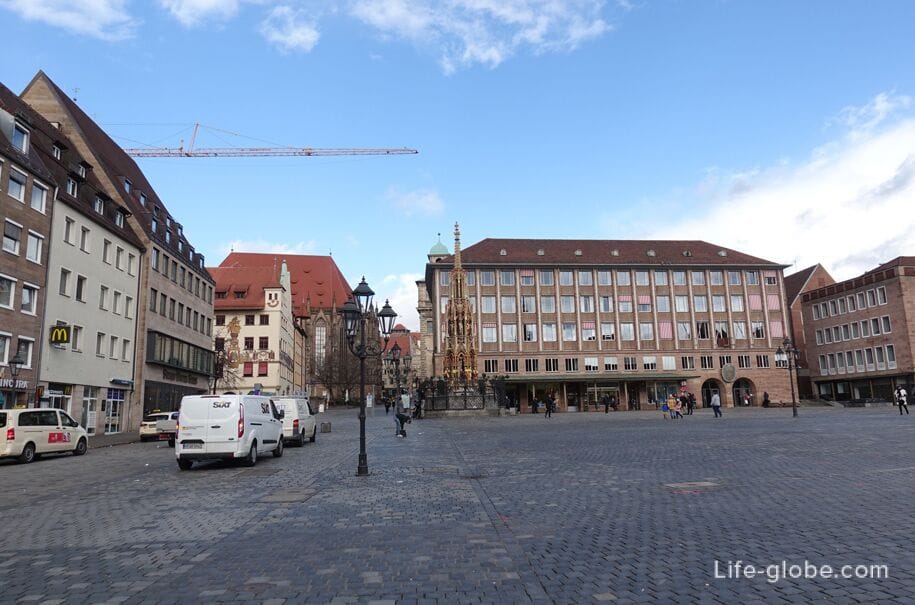
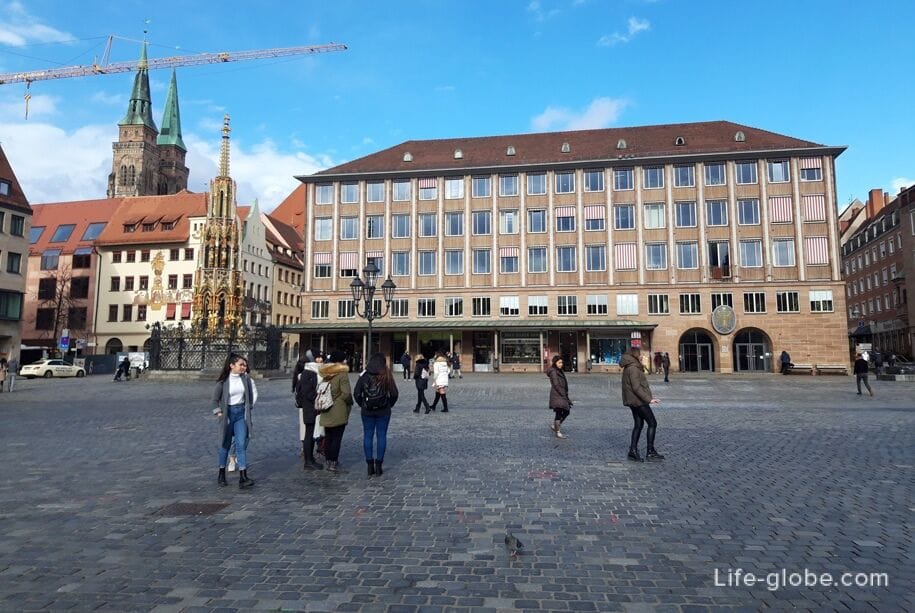
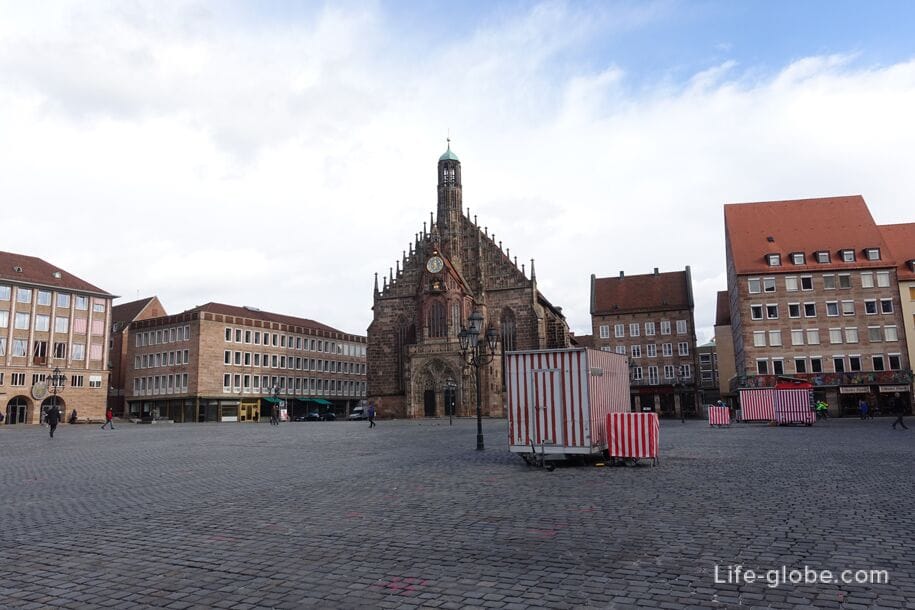
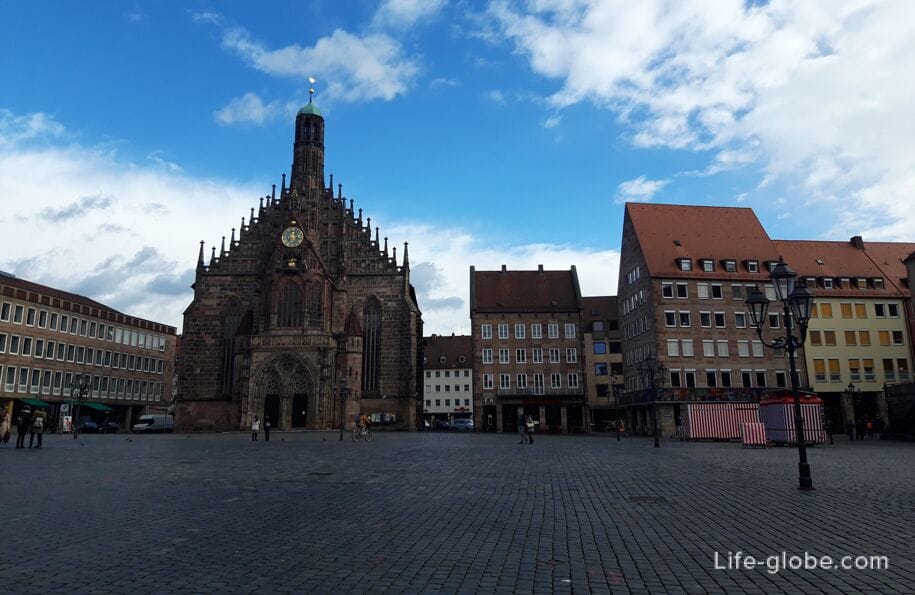
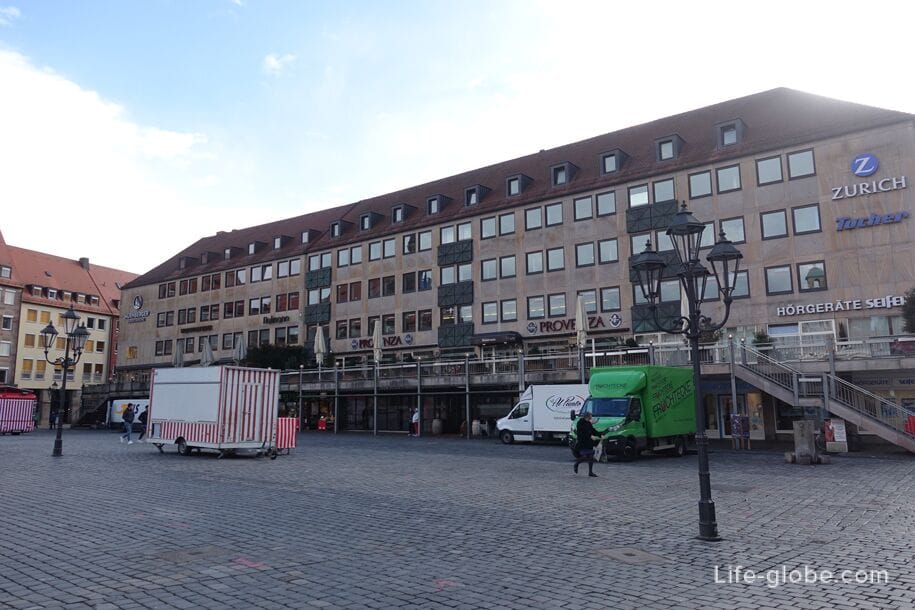
Sights and objects on the Nuremberg Market Square
The main appearance of the square is formed by two significant sights of Nuremberg, which are included in the tourist route (tour) – "Historical Mile of Nuremberg" (Historische Meile Nürnberg):
- A beautiful fountain or a Beautiful fountain (Schöner Brunnen / Schoener Brunnen), located on the northwestern edge of the square.
The fountain was built between 1385 and 1396 from sandstone. Today on the Market Square there is a colorfully painted copy of the fountain made of seashell - 1903.
The beautiful fountain has a height of about 19 meters and the shape of a Gothic church spire. It consists of four tiers, which are decorated with gilding and 40 colorful figures (statues), personifying and representing: scientists; evangelists and church fathers; electors and good heroes of different times; Moses and the prophets. Gargoyles in the lower part of the fountain symbolize the seven deadly sins, and are also designed to protect the city from dishonesty.
There is a rotating brass ring on the grating of the fountain. Legend has it that if you turn the "golden" ring of a beautiful fountain once, then three wishes will come true, and if you turn it three times, you can expect many children. More about the Beautiful Fountain...
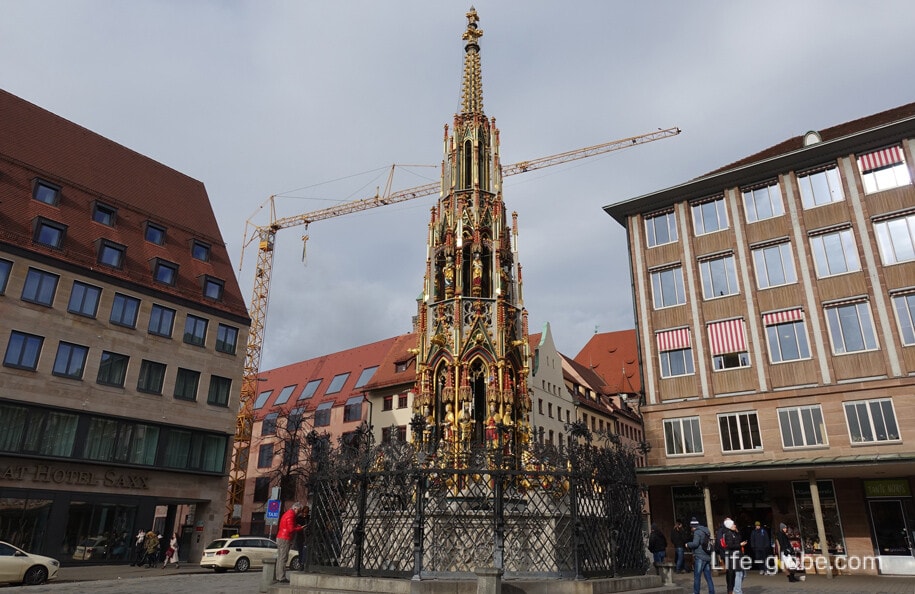
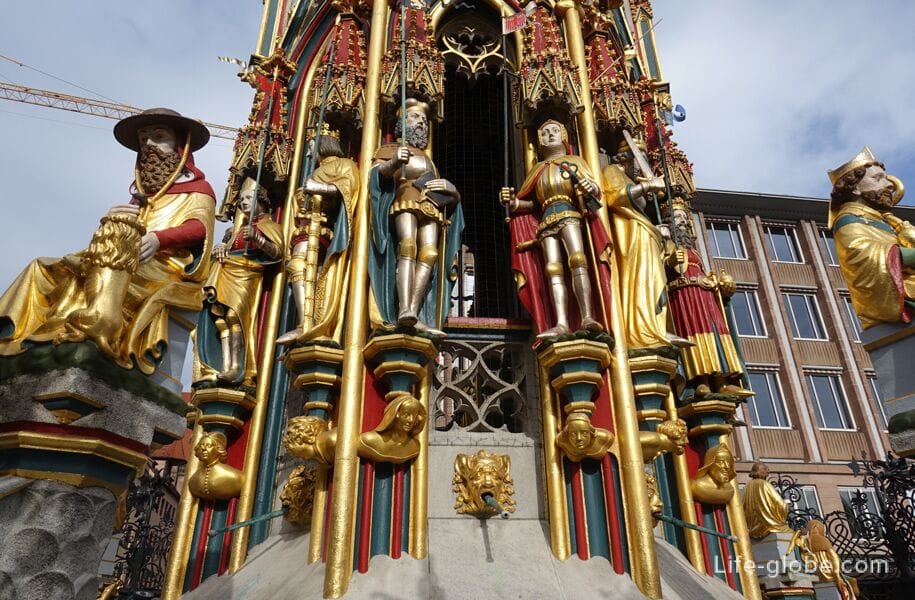
- the Church of the Virgin Mary or Frauenkirche, which is the main dominant of the square and is located on its eastern side.
The church was built as an imperial court chapel and a communal church building. The construction of the church was carried out from 1352 to 1362 on the initiative of Emperor Charles IV.
The powerful exterior Gothic appearance of the church immediately catches the eye.
In the upper part of the facade there is an art clock with moving figures. The Christmas market opens annually on the balcony with colorful figures. Every lunch break at 12 o'clock in the afternoon, the figures on the balcony "walk" - seven electors who have the right to elect emperors pay tribute to the Roman-German emperor Charles IV.
The interior of the Frauenkirche has three naves separated by tall columns.
The interior is dominated by the organ and the main altar, as well as numerous preserved works of art, including from the Middle Ages. More about the Frauenkirche...

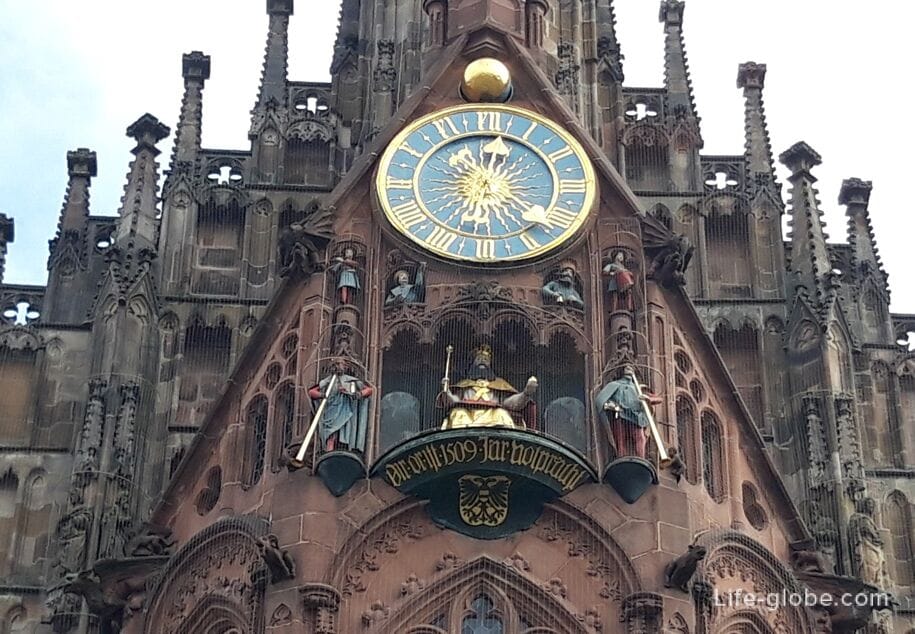

On the northern edge of the square, the ensemble of Nuremberg Town Halls is notable, consisting of the Old Town Hall and the New Town Hall:
- The Old Town Hall (Altes Rathaus) is one of the most important buildings of the city, where offices and authorities have been located since the Middle Ages.
The construction of the old town hall took place in several stages and also included reconstruction and expansion.
Today's architectural ensemble of the old town hall consists of two parts: the oldest part of the town hall - Gothic, built since the 14th century (between 1332 and 1340), and later, made in the style of the Italian Renaissance - built in the 17th century.
In the basements of the old town hall there is a museum of medieval dungeons (Mittelalterliche Lochgefängnisse), which consists of a historical dungeon prison, the cells of which have been used since the 14th century for interrogations and detention of prisoners before the execution of sentences;
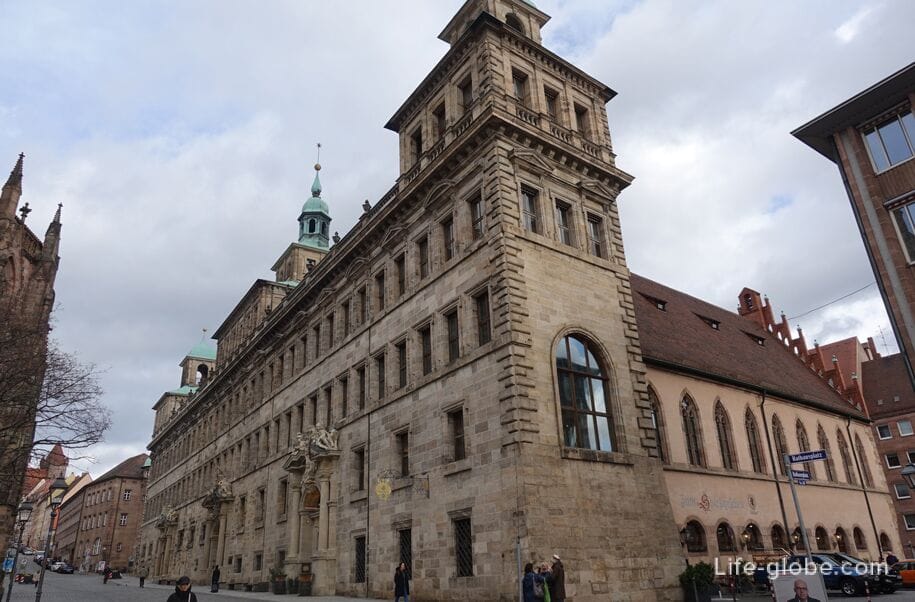
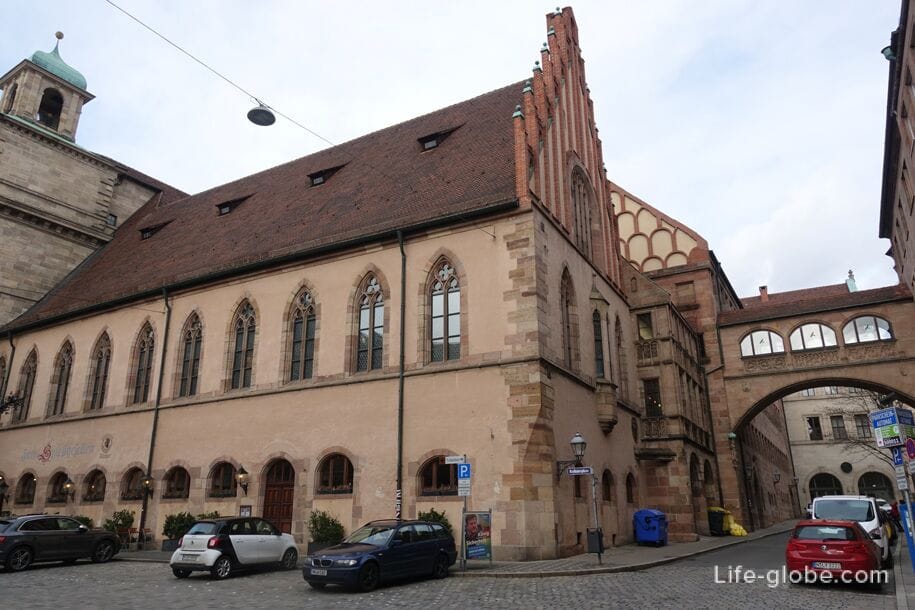
- The New Town Hall (Neues Rathaus) is a detached building located on the south side of the Old Town Hall.
The main facade of the new town hall faces the north side of the market square.
The buildings between the then existing Town Hall (today the Old Town Hall) and the northern end of the main market were destroyed during World War II. In 1951, architect Kurt Schneckendorf designed a New Town Hall in their place, which is also known as Schneckendorf-Bau (Schneckendorf-Bau).
The construction of the town hall took place from 1954 to 1956.
The new Town Hall is architecturally in sharp contrast to the Old Town Hall and is made in the style of the 1950s with a lattice facade. More about the town halls and the museum...
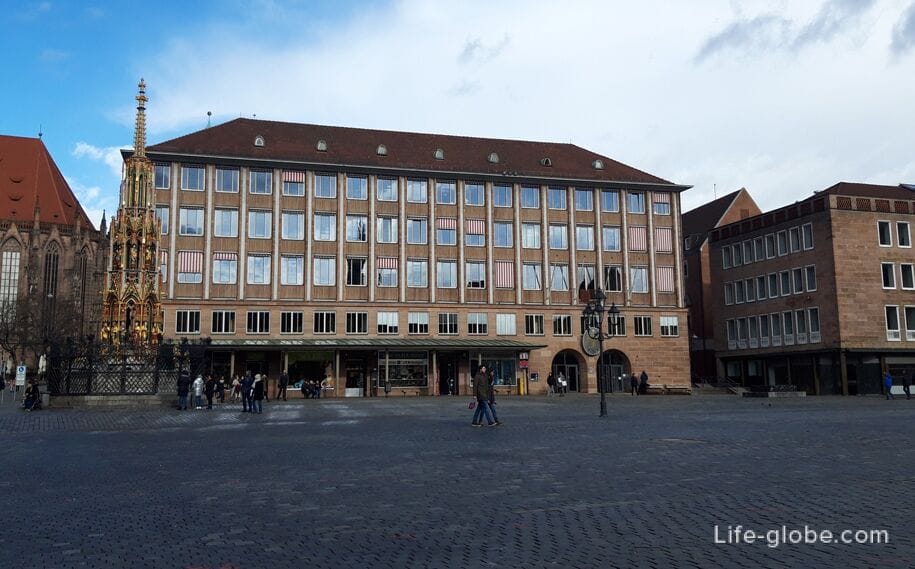
On the western side of the square, colorful buildings lined up in a row, which now houses cafes, restaurants and shops.
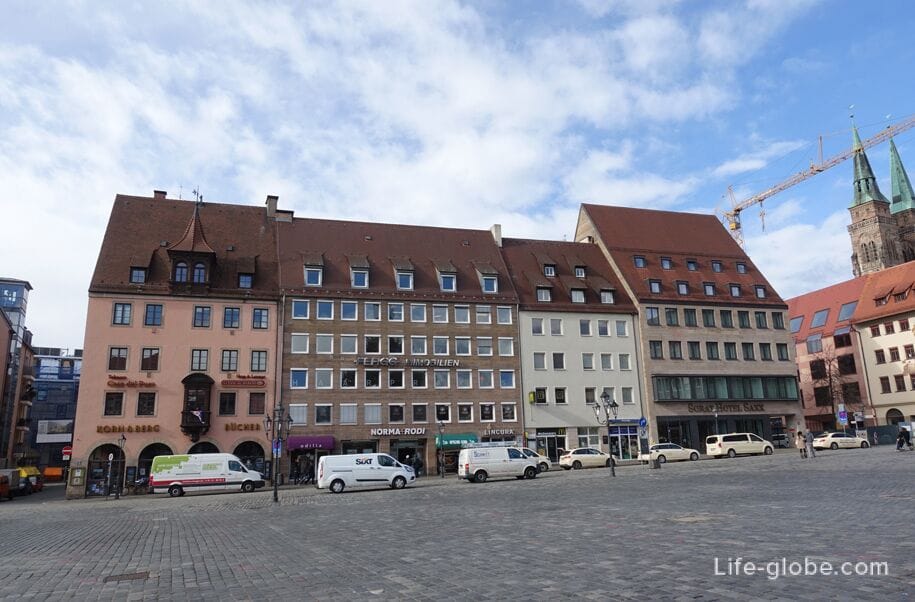
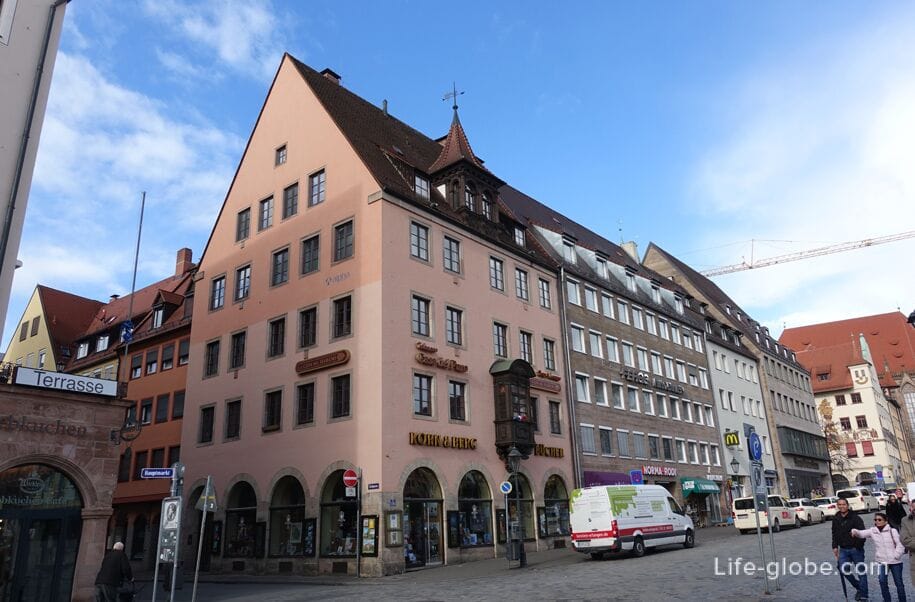
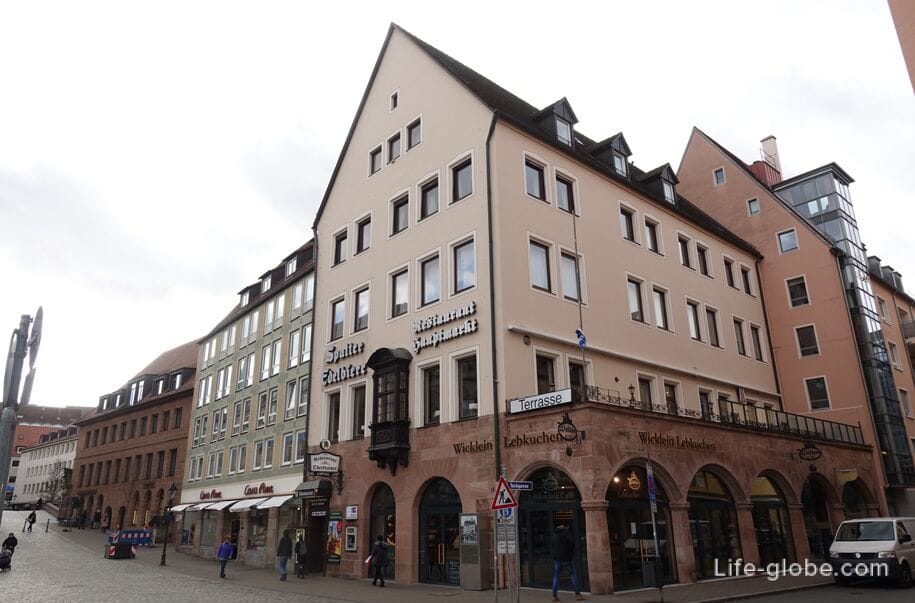
From the buildings on the western side of the Market Square , the following stand out:
- The House of Economics (Haus der Wirtschaft), which houses the Nuremberg Chamber of Commerce of Middle Franconia.
This place has been the seat of the Nuremberg merchants' self-government since 1560. The buildings were almost completely destroyed during World War II and restored to their current form in the 1950s.
Today, the building architecturally consists of separate houses and stands out with turrets, a portal and paintings on the southeastern facades. Address: Hauptmarkt 25/27;
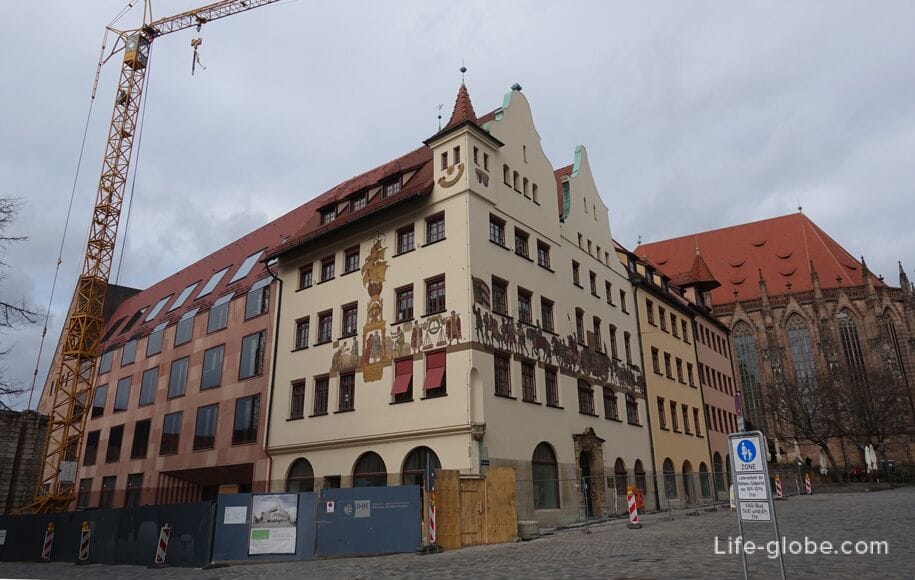
- on the corner house, located at Hauptmarkt 9 / Tuchgasse 2, there is a remarkable wooden choir (bay window), made partly from the remains of the choir of the early 18th century. There are shops in the building;
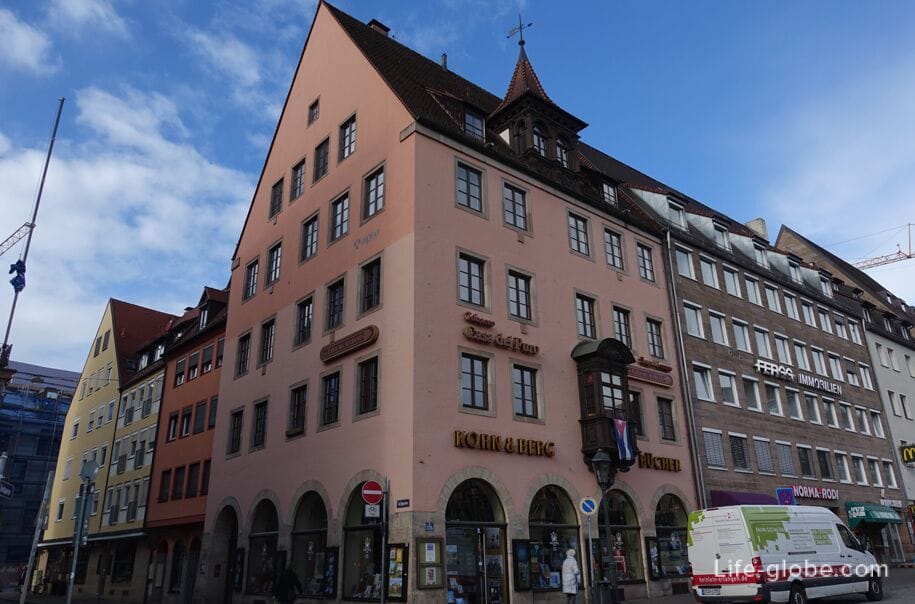
- corner house at the address: Hauptmarkt 7 / Tuchgasse, notable for a wooden bay window and an outdoor terrace on the 2nd floor level.
This historic house is called "Lebkuchen" (Haus der lebkuchen) and is the brand name of the famous Nuremberg gingerbread shops. The building also houses the restaurant "Oberkrainer".
The medieval building was built in the 15th century. Twice in its history, the building was almost completely destroyed and rebuilt. Since 1999, the building houses the company "Wicklein Lebkuchen" where gingerbread is sold. With more than 400 years of history, the company is a place of high craftsmanship and traditions of Nuremberg;
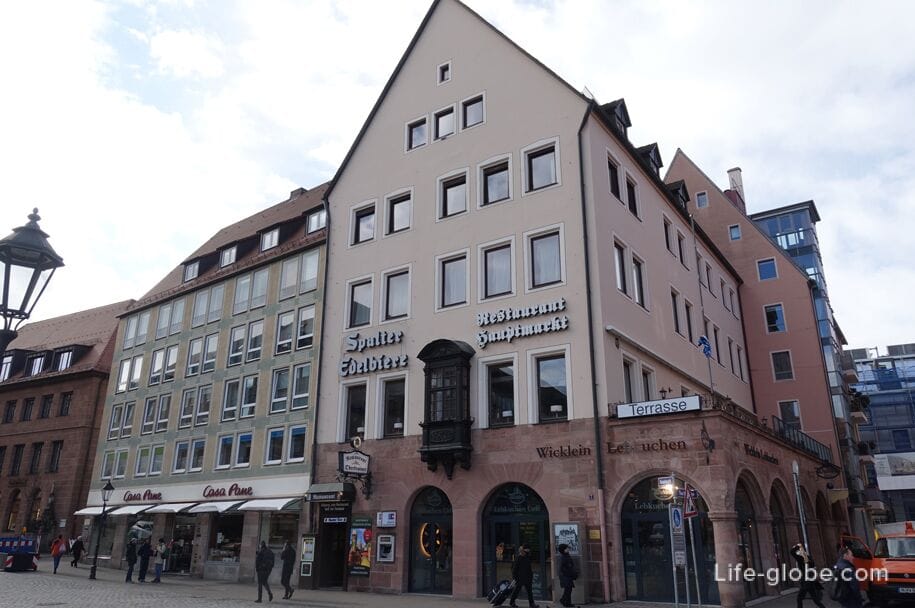
Historical photo of the building (1914)
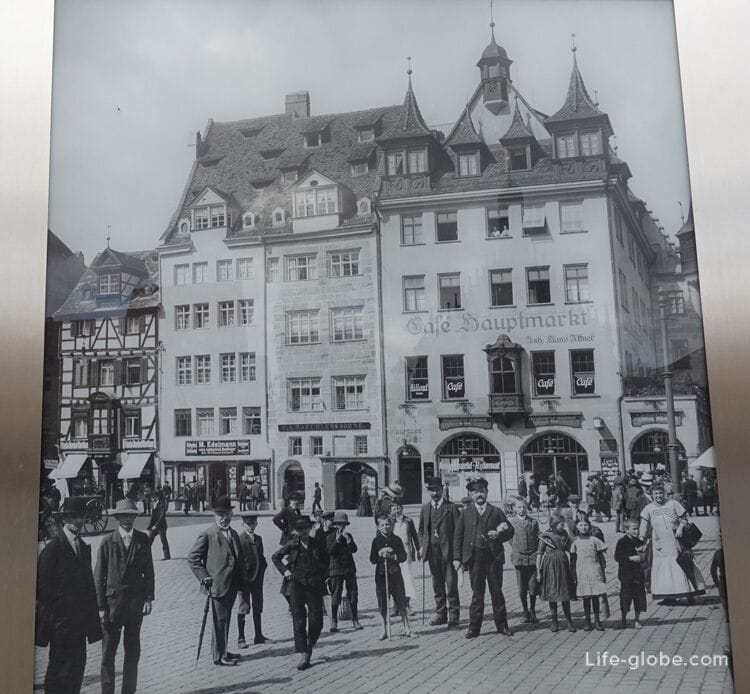
- former butcher shop (Fleischhaus), located at Hauptmarkt 1 and built in 1570-1571.
During the Second World War, the building was destroyed. Later, a more modern structure was erected in its place, which now houses cafes and shops.
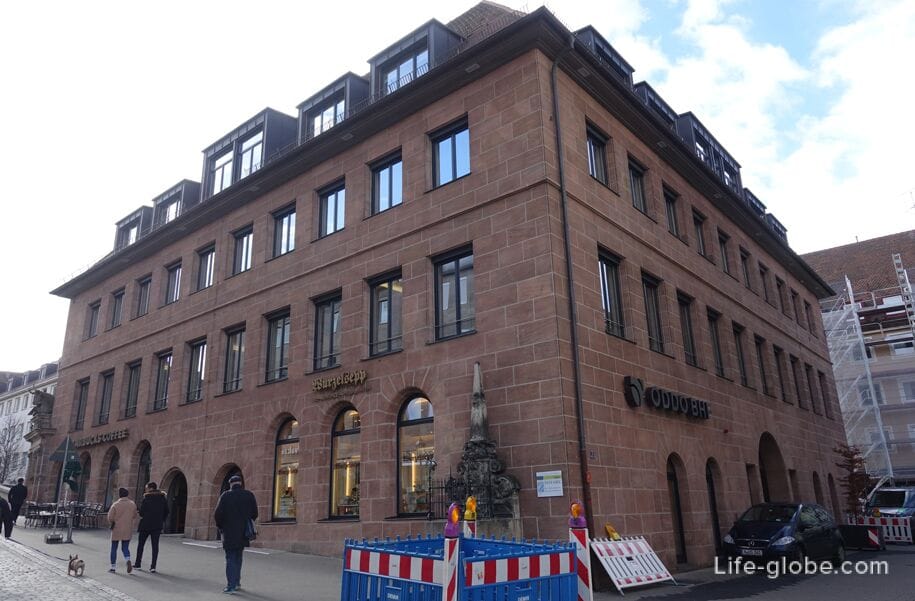
Near the building of the former butcher shop there are:
- a wall fountain (Wandbrunnen) dating from around 1600;
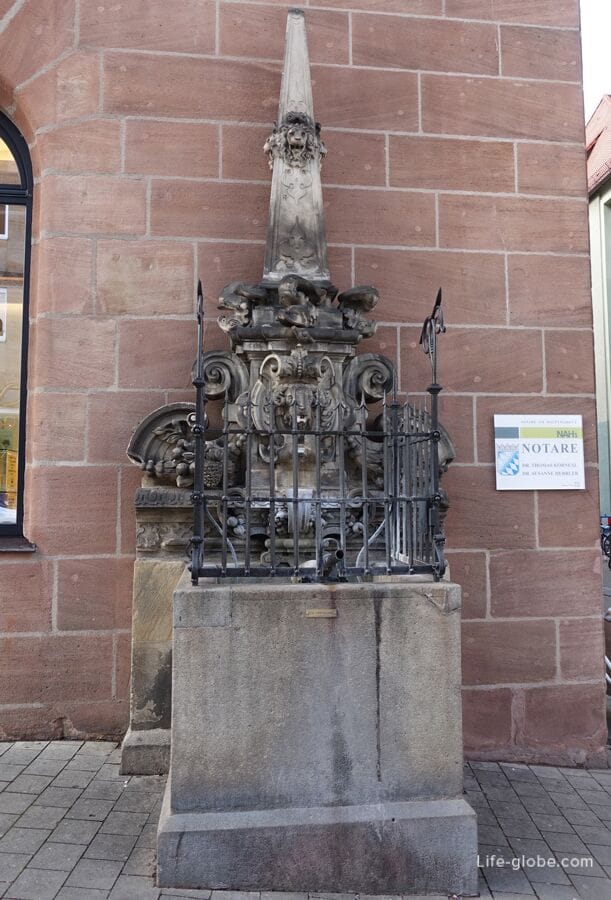
- the portal of the "Bull" (Das Ochsenportal), which rests on one side on the former Meat House, and on the other side is adjacent to the Meat Bridge.
The portal is decorated with carvings and a stone figure of a reclining bull in the upper part. The portal was built in 1599 as the entrance gate to the Meat House building.
The portal was damaged during the Second World War. In 1950, the ox on the portal was replaced by a slightly modified copy.
The Latin inscription on the portal reads: "Omnia habent ortus suaque incrementa sed ecce quem cernis nunquam bos fuit hic vitulus", which translates roughly as: "All things have their origin (beginning) and growth, but look: the bull you see here has never been a calf."
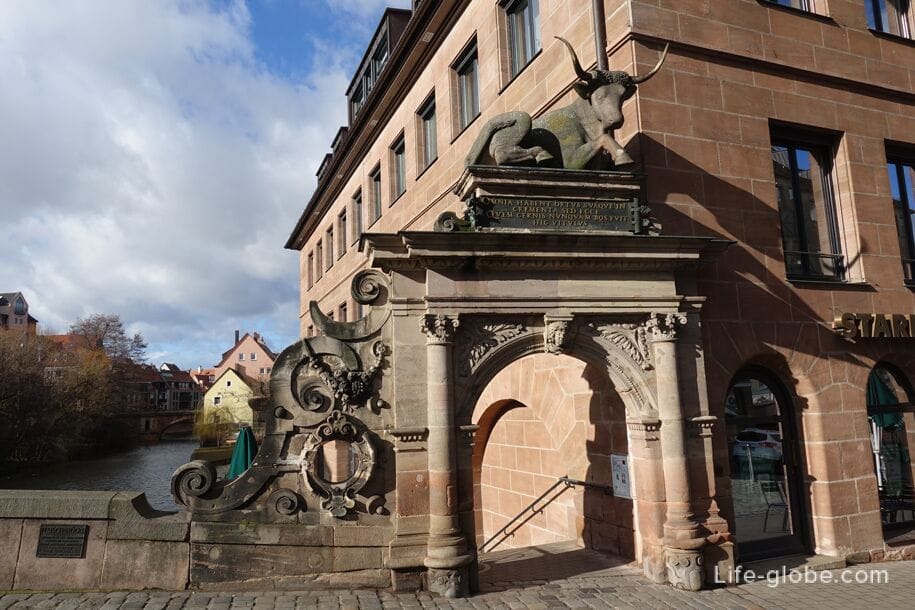
At the southwestern tip, the Market Square flows into the Meat Bridge (Fleischbrücke), which runs across the Pegnitz River.
The bridge has one flat stone arch. In the center, on both sides (east and west), the bridge is decorated with two small projecting balconies. On the outside of the western balcony are the stone coats of arms of seven members of the city government of that time. More about the Meat Bridge...
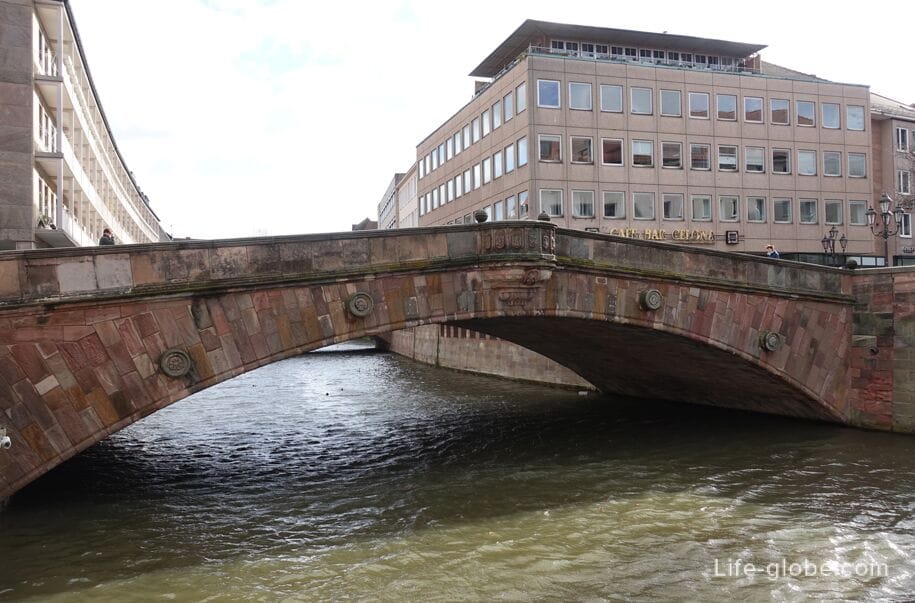
The historical object of the Market Square was the Fountain of Neptune (Neptunbrunnen), created by Nuremberg craftsmen in 1660-1668 as a memorial to peace after the end of the Thirty Years' War.
In 1797, the city sold the fountain of Neptune to the Russian Emperor Paul I, who sent the fountain to the city of St. Petersburg to install it in his summer residence, in Peterhof. The fountain was slightly modified to suit the style of classicism. Now the Neptune fountain can still be seen in Upper Garden The Grand Palace of Peterhof in St. Petersburg.
At the end of the 19th century, attempts were made by the German side to buy the fountain back, but the refusal was received from Emperor Alexander III, however, as a gesture of reconciliation, it was allowed to make plaster casts of the original.
A copy of the lost fountain of Neptune was created in 1896-1902.
On October 22, 1902, the Neptune Fountain was opened on the Nuremberg Market Square.
In 1934, the National Socialists removed the Neptune Fountain from the square, because they considered it a "Jewish fountain" and it interfered with processions and rallies on the square.
Since 1962 , the Fountain of Neptune has been located in The city Park of Nuremberg (Stadtpark) and is considered the largest Baroque fountain north of the Alps.

Markets, fairs and events on the Market Square
Weekly market (Green Market), which is held on the Market Square from Monday to Saturday from 7:00 to 20:00 hours. Attention! The days and hours of the market may vary. We recommend that you clarify the information immediately before visiting.
On Christmas Eve and New Year's Eve, the largest historical Christmas market in the city - "Christkindlesmarkt" (Christkindlesmarkt) is held annually on the square. Approximate dates: from November 25 - December 1 and until December 24. About 2 million people visit Nuremberg during the pre-Christmas fairs. Learn more about the Christmas markets in Nuremberg...
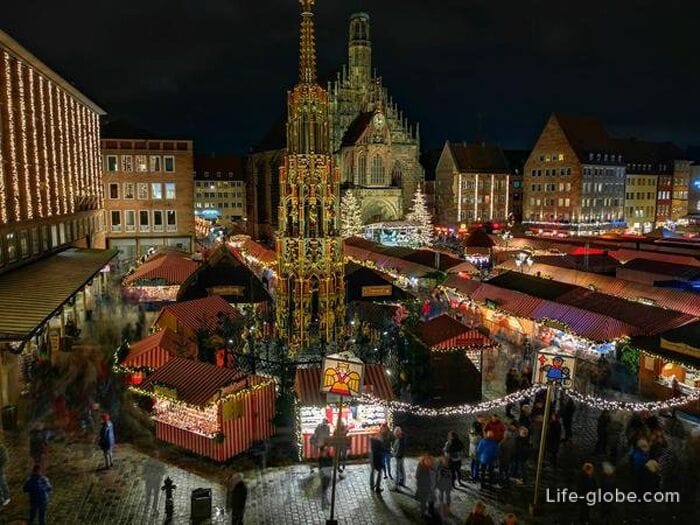
Twice a year - on the second weekend of May and September, in the old town of Nuremberg - on the Hauptmarkt and in the vicinity of the square, the Trempelmarkt (Trempelmarkt) is held - the largest "flea market" in Germany, which is visited by up to 200,000 people.
The three-day music festival "Bardov Meetings" (Bardentreffen), which takes place in Nuremberg, including on the Market Square, every summer. The festival begins on the first Friday of the Bavarian summer holidays.
In addition, other celebrations, concerts and social events are held on the square throughout the year.
Where to stay near the Market Square
The 3-star Sorat Hotel Saxx Nürnberg is located directly on the central Market square.
The hotel offers a view of the Market Square.
At the hotel: free Wi-Fi, bar, luggage storage, 24-hour front desk and parking.
The rooms are equipped with air conditioning, a private bathroom and a flat-screen TV with satellite channels. Link to the hotel
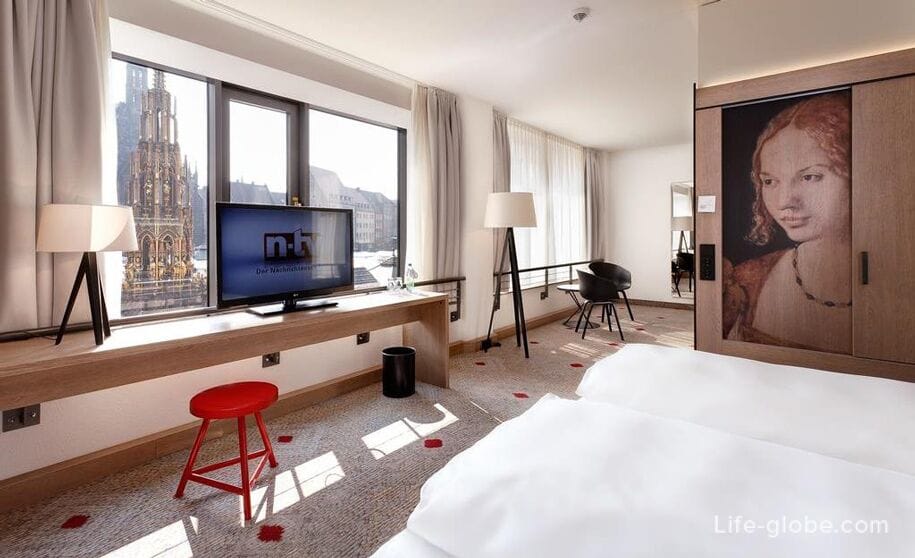
The 3-star Five Hotel features a terrace, restaurant, bar, free Wi-Fi, parking and luggage storage.
The rooms are equipped with a seating area, a work desk, a flat-screen TV with satellite channels, and a private bathroom with free toiletries and a shower.
Breakfast is included in the room rate. Link to the hotel
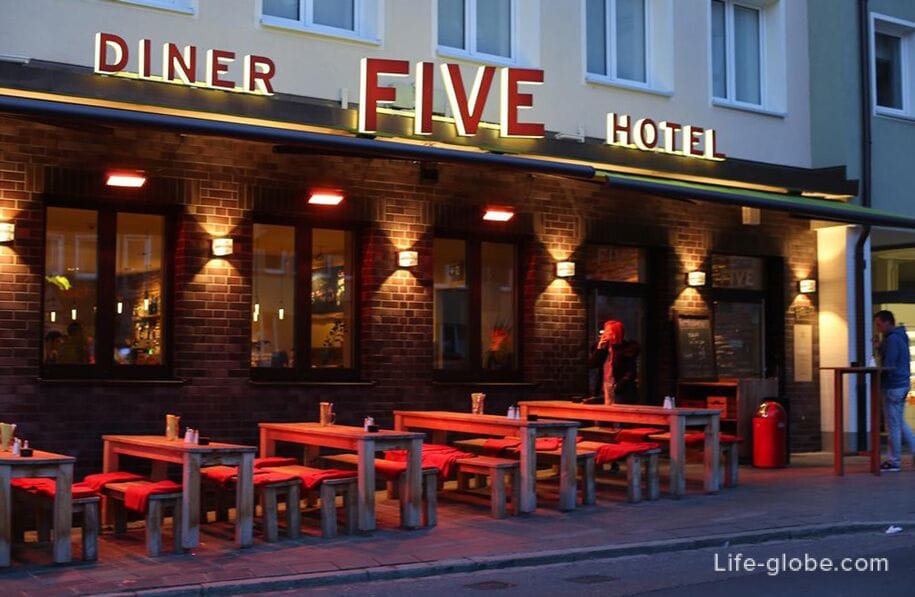
Central Hotel offers free Wi-Fi, parking, heating, elevator and buffet breakfast.
The rooms are equipped with a flat-screen TV and a free bottle of mineral water upon arrival. Link to the hotel
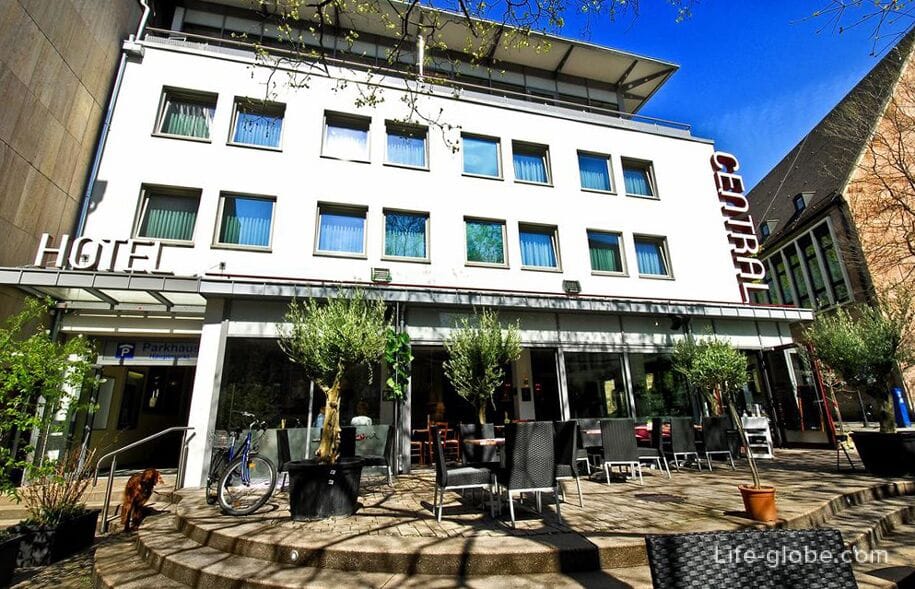
dasPaul Hotel offers free Wi-Fi, a restaurant, a bar, parking, luggage storage and family rooms.
The rooms are equipped with a desk, a flat-screen TV, a coffee/tea maker, and a bathroom with a shower, a hairdryer and free toiletries.
Breakfast may be included in the room rate. Link to the hotel

All accommodation facilities in Nuremberg, including in the city center and near the central Market Square, can be viewed and booked here








